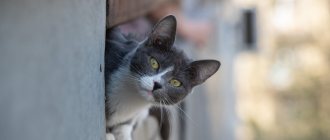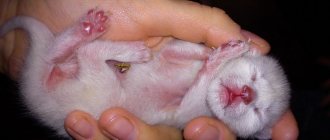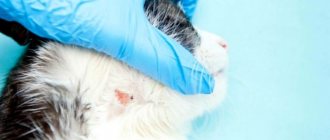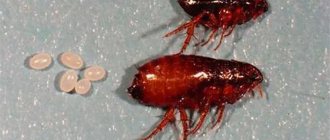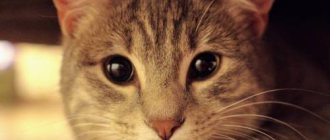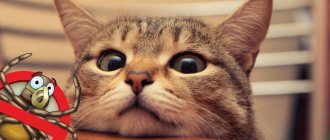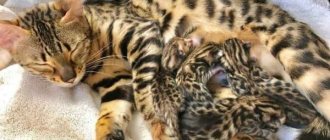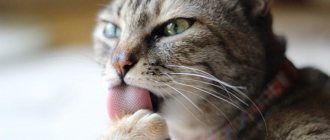If a long-awaited kitten adopted from a breeder appears in the house, the question of its age does not even arise, because the day of its birth is precisely indicated in the passport. It is somewhat more difficult with kittens purchased at the poultry market, because an error of a couple of weeks is possible. What to do if your heart trembles at the sight of a street stray and you are ready to shelter such a cat? How to determine the age of a cat if it comes to you no longer as a cute kitten? This is not an idle interest, but a matter of the health of the cat and all households. Certain diseases or behavioral changes in cats occur at specific ages, so it is necessary to prepare for them. A phenologist can easily determine the age of an animal, but it is not always possible to contact him, so we will try to learn how to do this at least approximately.
TO find out the age, you need to carefully and slowly examine the pet
DETERMINING THE AGE OF A CAT BY TEETH
Determining the age of a cat by its teeth is quite simple.
First, the color of the teeth changes, then there is slight abrasion of the incisors on the lower jaw, then on the upper. The last ones to fall out are the fangs.
Below is the condition of the teeth and the age of the cat:
- - all molars are white and look strong - the cat is 6 months to 1 year old;
- - there is some yellowing on the teeth - the cat is just over a year old;
- — on the lower jaw of the animal there is slight abrasion of the central incisors — the cat’s age is 1.5-2 years;
- — on the lower jaw there is slight abrasion of the middle incisors — the cat’s age is 2 years;
- — tartar has appeared on the teeth – the cat is just over 2 years old;
- — abrasion of the central incisors is noticeable on the upper jaw; the cat is 3-3.5 years old;
- — there is abrasion of the middle incisors on the upper jaw; the cat is 4-4.5 years old;
- - noticeable wear of the fangs - the cat’s age is 5-5.5 years;
- - wear of the outer incisors is noticeable on the upper jaw - age - 5.5-6.5 years;
- — there is abrasion of the central incisors on the lower jaw; the cat is 7-7.5 years old;
- - abrasion of the middle incisors on the lower jaw - age - 7.5-8 years;
- - on the upper jaw there is significant abrasion of the central incisors - 8.5-9 years;
- — there is significant wear on the middle incisors on the upper jaw; the cat’s age is 9.5-10 years.
As a rule, from the age of 10, cats begin to gradually lose teeth:
- — if the lower incisors have fallen out on the cat’s lower jaw — the cat’s age is 10 years;
- — the middle incisors on the lower jaw have fallen out — the cat’s age is 11 years;
- — central incisors fell out on the upper jaw — age — 12 years;
- — the middle incisors fell out on the upper jaw — age — 13 years;
- — loss of all incisors begins from 12 to 14 years;
- - tooth loss begins between 14 and 15 years of age.
Determining the age of the kitten
At 1 month, kittens erupt their first milk teeth.
At 5-6 months, baby teeth are replaced by molars.
Option three, available to every owner.
If the foundling came to you at an indefinitely early age, and you find it difficult to determine its age by its teeth, then you should wait until the young lady is drawn to “bunches” and, starting from this time, calculate the age of the kitten.
In cats, depending on the breed and constitution, puberty occurs at 6-10 months. That's when the first howls begin. Of course, you won’t breed your bright-eyed beauty in her first heat, but you can guess her age.
Around the same time, a young cat (8-10) begins to mark, so if you are not a fierce opponent of castration, then it is advisable to deprive the cat of the opportunity to spray cat scent as early as possible.
Fully domestic kittens will grow and mature no earlier than a year, and especially large specimens (breeds) of kittens grow until the age of 16-18 months, then the time for paternity and motherhood will come.
Street cats begin sexual activity much earlier, age earlier, lose teeth earlier, die earlier...
DETERMINING THE AGE OF A CAT BY EYES
Determining the age of a cat by looking at its eyes can only give an approximate result.
A young animal, as a rule, has transparent, perky, inquisitive eyes
, in which interest and mischief sparkle. Over time, gradual clouding of the eye lens occurs, which is a sign of deteriorating vision and the possible appearance of cataracts.
Iris brightness
The eyes are also an indicator of the cat's age. If the iris has any spots, there is an asymmetrical pattern on it, or it is cloudy in structure, then this indicates that the cat has long passed its “tender” age.
Two to three months
As a rule, a two-month-old kitten is already able to cope with moving to a new family and getting to know a new environment. The baby can now be switched to natural products or dry food without significant harm to its health.
Vaccination
This age is largely a turning point due to the fact that it is between two and three months that the kitten undergoes its first vaccination.
Respectable breeders warn the buyer in advance whether the kitten requires any vaccinations and whether they have been given previously
Mandatory vaccinations include vaccinations against the following diseases:
- calcivirosis;
- panleukopenia (or plague);
- rhinotracheitis;
- rabies.
In addition to these diseases, the breeder can also include others at his discretion.
Vaccination schedule
As a rule, vaccination requires a certain age of the kitten and strict intervals between which the procedure must be repeated:
- the first “approach” is made at 8 weeks or two months. By this time, the kitten is strong enough to undergo vaccination without weakening. At this age, the kitten is vaccinated against all the diseases mentioned above, except for rabies;
- at four months the kitten goes through all the same vaccines again, now including rabies;
- at five months the same vaccinations are repeated as at four months.
Vaccination schedule for kittens from birth to one year
Subsequently, the pet will need to be vaccinated annually so that the body does not have time to lose the developed immunity.
Features of vaccination
A natural question may arise: “Why can’t I take the kitten to the veterinarian for vaccination and take it home?” Of course it's possible. Moreover, some owners do exactly this, buying a kitten at two months of age.
Vaccination temporarily weakens the kitten and makes it vulnerable to various diseases.
However, when taking such a step, it is necessary to be aware of the responsibility that the future owner of the animal places on his shoulders:
- firstly, there is a high probability that when moving, a kitten that has not yet been vaccinated may become infected with some disease that will be difficult for the fragile body to fight;
- secondly, the first vaccination is often not easy for a kitten. Cubs sometimes develop complications that quickly go away with the correct response from the owner. However, it can be difficult for an inexperienced person to react correctly and take the necessary actions in a timely manner.
Sometimes kittens may develop complications after vaccinations.
Of course, a two-month-old kitten will not die in your arms if you do not provide him with proper care during vaccination, but this period is very difficult for both the animal and its owner. But ultimately, assessing risks and setting your preferences is a personal matter for everyone.
Read with this
DETERMINING THE AGE OF A CAT BY HAIR
You can find out the approximate age of a cat by its fur.
Typically, young animals have smooth, soft and thick fur. Cats up to 4-5 years old can boast of this “dignity”.
The fur of older cats is less shiny, it is not as thick and elastic. As a rule, a cat at the age of 7 already has gray hairs.
Older animals have dull coats and their fur is brittle rather than elastic. In older long-haired cats, mats in the fur are common because... the animal no longer pays attention to its appearance.
Cat behavior
You can also find out the age of a cat by its activity. The influence of age affects not only the appearance of a pet, but also its habits. Young cats that have just begun their life journey are inquisitive and playful, they are interested in everything new. Middle-aged cats already have life experience; they still show interest in everything new, but they are very cautious and have established habits. Older cats are also not devoid of interest in the world around them, but they can no longer actively move and sleep more often than they are awake.
As cats age, they often begin to show aggression towards strangers; this is associated with increased anxiety and fearfulness. Also, older cats often suffer from a number of chronic diseases, which worsens their well-being, and communicating with a curious stranger does not seem to be the best idea for them against the background of general malaise.
DETERMINING AGE BY BODY STRUCTURE
Over time, the cat gradually loses its activity. It is quite natural that a decrease in physical activity has a direct impact on changes in the animal’s body structure. Thus, young cats are very active and this is characterized by their muscularity and healthy thinness.
Cats aged 3-7 years are already more rounded and well-fed. They are less active and “economical” in their movements.
Older cats have prominent shoulder bones and tend to have loose skin.
OTHER SIGNS OF DETERMINING THE AGE OF A CAT
In addition, the approximate age of a cat can be determined by the pads on its paws.
:
- - if they are pink and smooth, the cat is still young enough,
- - if there are cracks and pads on the paws and they are worn out, then the cat is already in adulthood.
Don't forget to check the claws
:
- - In older cats, the claws may be fragile and broken off in some places. In young individuals, the claws are usually very strong.
Also pay attention to how long your cat sleeps.
. If your purr sleeps a lot, chooses between playing and a warm bed, the second option, then it is quite possible that your cat is already an old lady.
Appearance
- Condition of the coat. If it is shiny and thick, the pet is young. If the coat looks unhealthy and dull, the cat is elderly. This method has inaccuracies. Cats' fur can deteriorate significantly in the presence of various diseases and helminthic infestations.
- Muscle mass. If young cats have visible muscle relief, older cats are more well-fed and round. Old cats lose weight and stoop. The skin becomes loose and flabby.
HOW OLD IS A CAT BY HUMAN STANDARDS?
The average lifespan of cats is 13-15 years. However, many of us are interested in how old a cat is by human standards. There is no standard formula for determining the ratio of the age of a person and a cat, but there are approximate data that allow us to answer this question.
So, the age of a cat “increases” in inverse proportion to the age of a person. But it is also important not to forget that the lifespan of a cat depends on the conditions of its keeping and on its belonging to a particular breed.
- - cat 1 year old - human 15 years old
- - cat is 2 years old - human is 23 years old
- - cat is 3 years old - human is 27 years old
- - cat is 4 years old - human is 32 years old
- - cat 5 years old - human 35 years old
etc.
The oldest cat can be probably 23-25 years old. This age corresponds to 100 years in humans.
Features of the cat's life cycle
A year in the life of a cat is a long and significant period. It is equivalent to approximately four to five human years. Knowing this, it is easy to understand why cats suddenly develop arthritis, lose their vision, or stop hearing well in a fairly short period of time. A popular and erroneous method, as we wrote above, is the “seven-year” method of converting cat years into human years: one cat year is not equivalent to our seven. This is due to the fact that in the first two years the cat matures faster than in the rest. So, in the first year the cat reaches the age of 15 human years, in the second - she is already a 24-year-old person. Each subsequent year is equal to approximately 4 years of ours. After some simple calculations, we get: the age of a five-year-old cat is 36 human years (see table below). It should also be taken into account that a cat who lives on the street ages much faster, perhaps even twice as fast, than a well-groomed indoor cat.
In the first year of life, a cat reaches the age of 15 human years
HOW MANY YEARS DO DOMESTIC CATS LIVE?
The lifespan of domestic cats depends on many factors.
Firstly, it belongs to a certain breed. For example, representatives of less “elite” breeds are longer-livers than their “aristocratic” counterparts.
Secondly, their sexual activity plays a huge role in the lifespan of domestic cats. If a domestic cat (cat) does not have the opportunity to have an active sex life, then the excess of their unrealized hormones has a negative impact on their lifespan.
- The third factor is heredity.
- The fourth factor is lifestyle.
- The fifth factor is diet.
- The sixth factor is the emotional state of the animal.
- The seventh factor is the level of disease resistance.
Considering all the above factors, it is not entirely correct to talk about the life expectancy of domestic cats. Theoretically, a healthy cat under ideal conditions can live up to 25 years, but this is more the exception than the rule.
Exceptions to the rules
Despite the variety of methods, there are factors that can interfere with correct calculation:
- Heredity. The individual characteristics of the animal in appearance and behavior may not correspond to age standards.
- Presence of diseases. Poor health and exhaustion of a cat can affect its behavior and appearance.
- Conditions of previous content. If a cat previously lived in street conditions and did not receive the necessary vitamins, in appearance it will look much older than its domestic relatives.
